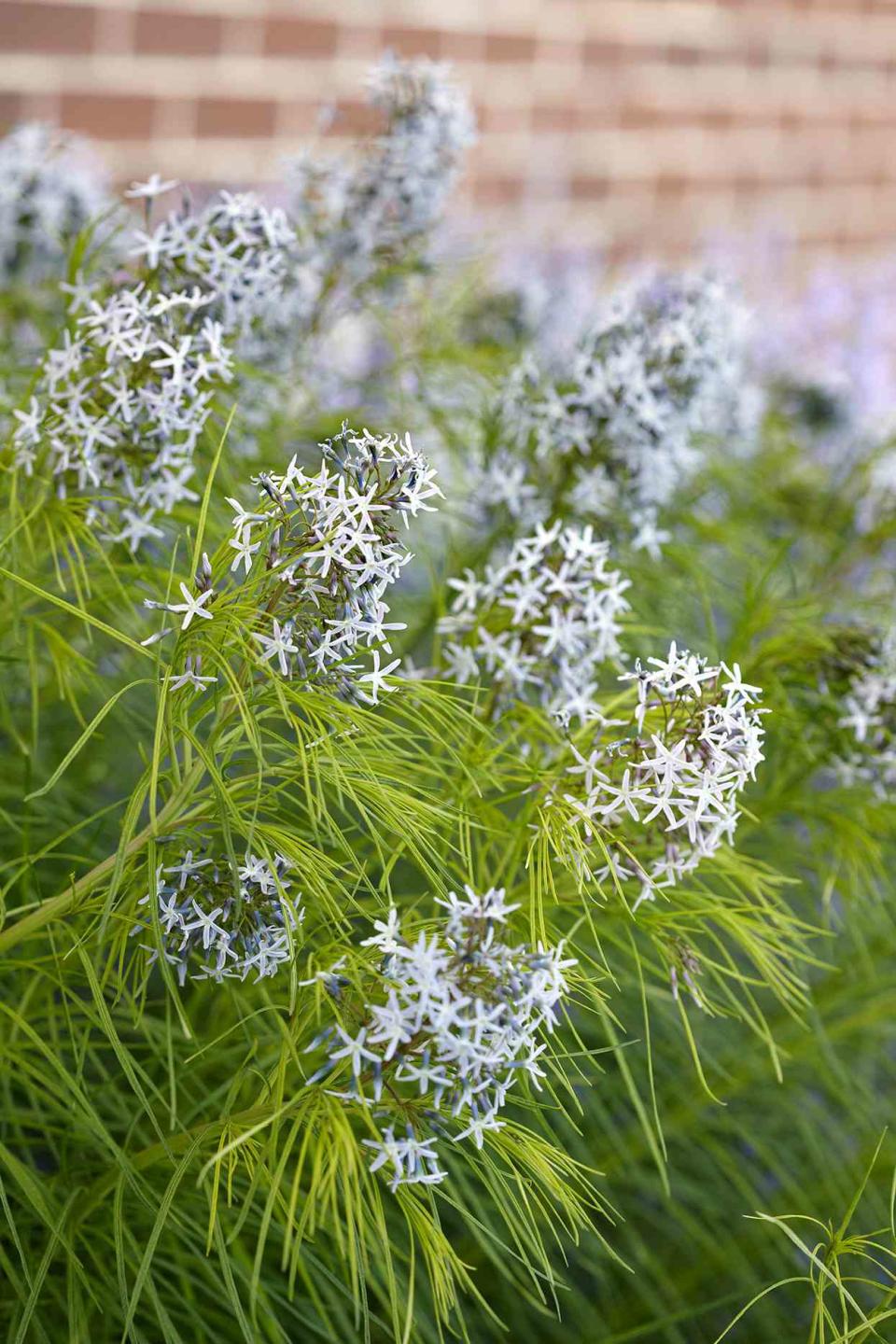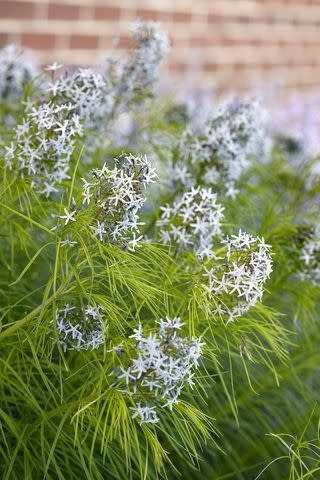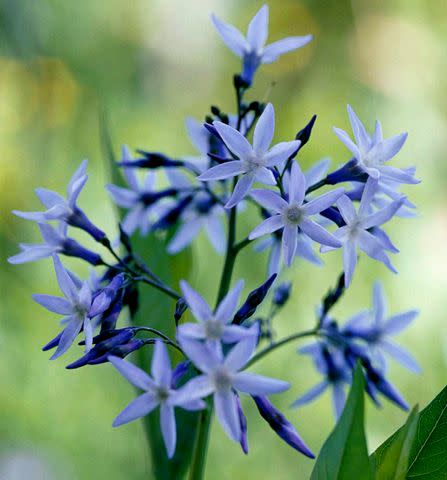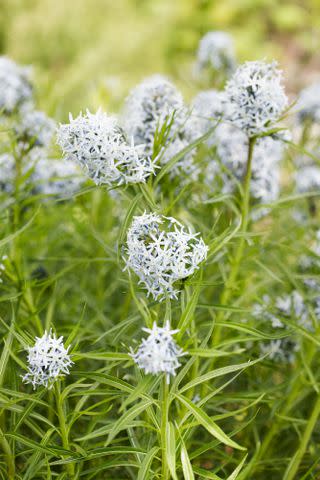How to Plant and Grow Threadleaf Bluestar
This low-maintenance native perennial has beautiful blue flowers that resemble small stars.

Threadleaf bluestar (Amsonia hubrichtii) will be the star of your beds and borders for three seasons. This native perennial boasts clusters of pale blue star-shaped flowers in spring, fine green foliage through summer, and brilliant yellow-gold fall color. Indigenous to Arkansas, Missouri, and Oklahoma where it grows in meadows, this bluestar also attracts pollinators and offers the desirable features of deer resistance and low maintenance.
Where to Plant Threadleaf Bluestar
Plant threadleaf blueststar in locations with full to partial sun in well-drained, fertile, slightly acidic soil. Great places are perennial border gardens, around patios and decks, and native habitat gardens. This plant needs a modest amount of space where its upright stems, fine texture, spring flowers, and fall color can shine. Planted in groups of three to five plants, it adds a stunning design feature to your garden: When its brilliant yellow fall color draws all the yellow-leaved plants in your garden together, it creates a warm glow during chilling autumn weather.

How and When to Plant Threadleaf Bluestar
Bluestar is a hardy perennial that may be planted whenever the ground is workable and the plants are available. Dig a hole about twice the diameter of the root ball and about the same depth. Place the plant in the hole and backfill it with the original soil. Gently tamp it down and water it immediately.
Space the plants 2 to 3 feet apart.
Threadleaf Bluestar Care Tips
Light
Plant threadleaf bluestar in full sun to get the most spectacular color and prevent flopping (which is especially important with taller varieties). In regions with very warm summers, plant bluestar in part shade.
Soil and Water
Threadleaf bluestar prefers fertile, well-drained soils with a pH between 5.6 and 6.2. It's more drought-tolerant than other Amsonia species and doesn't require constant moisture.
Temperature and Humidity
This is a cold-hardy perennial that is adapted to winters down to zone 5. It is not suited for extremely hot summers above zone 9 but does fine in high humidity.
Fertilizer
If you planted it in fertile soil, threadleaf bluestar does not need any fertilizer at all other than a thin sprinkling of well-aged compost around the base in the spring when growth restarts.
Pruning
If needed, cut back the stems by up to one-third after blooming to avoid stems leaning from the weight of the seedpods or when planted in more shady conditions. Leave the rest of the plant so you can enjoy upright stems full of green the rest of the summer, then brilliant yellow-gold leaves in fall.
Potting and Repotting
You can grow amsonia in pots, provided they are tall and large enough to accommodate the plant’s large taproot system and have large drainage holes. Choose a container that amply fits the plants plus at least 2 inches in diameter and fill it with well-draining potting mix and a few handfuls of compost. Keep in mind that despite the plant’s winter-hardiness, the roots are exposed in containers, unlike in garden soil. In areas with cold winters, you need to insulate the roots by sinking the container in the ground or winterizing by placing it in a second, larger pot to create a planting silo. Also, potted plants need more water and fertilizer during the growing season than in-ground plants.
Repot it to a larger pot with fresh potting mix when the root system has reached the sides of the container or grows out of the drainages holes.
Pests and Problems
Threadleaf bluestar is not susceptible to serious insect problems or diseases, although rust is a possibility.
How to Propagate Threadleaf Bluestar
Threadleaf bluestar can be propagated by division or from seeds. Divide the plant early in the spring before it starts to grow by digging out the entire clump, then cut it into sections with a spade or garden knife. Replant the sections at the same depth in new locations.
Starting threadleaf bluestar from seed requires cold stratification but you can let nature do the job for you. Just leave the seedheads on the plant and it will reseed itself. Carefully dig out the seedlings when they are about 4 inches tall and replant them in a new location.
Types of Bluestar
Eastern Bluestar

Eastern bluestar (Amsonia tabernaemontana) produces large clusters of light blue star-shaped flowers in spring. This perennial attracts pollinators such as bees and butterflies. Eastern bluestar is also deer resistant and is hardy in Zones 3-9.
Fringed Bluestar

Fringed bluestar (Amsonia ciliata) has pale blue starry flowers that appear in mid spring. The stems and new leaves have small hairs, hence the "fringed" part of its name. This bluestar tops out at 3 feet tall and is hardy in Zones 5-9.
Shining Bluestar

Marty Baldwin
Shining or Ozark bluestar (Amsonia illustris) has narrow leaves that look shiny. Its ice-blue flower clusters appear in spring. It's hardy in Zones 5-9.
Threadleaf Bluestar Companion Plants
Butterfly Weed

Better Homes & Gardens
Butterfly weed (Asclepias tuberosa) offers blooms in a complementary orange color that may overlap slightly with bluestar's bloom time. This small to medium-size perennial works well in a wildlife garden because, like all members in the Asclepias genus, it provides food for the larvae (caterpillars) of the Monarch butterfly.
Peony

Peonies (Paeonia spp.) bloom in spring in shades of pink, red, yellow, and white. The big, bold flowers and coarse foliage contrast nicely with threadleaf bluestar. These plants are also deer-resistant.
Siberian Iris

Spring-blooming Siberian iris (Iris sibirica) complements threadleaf bluestar flowers with its own blue or purple flowers. Some varieties of this type of iris also come in white or yellow. The plants are deer-resistant and the flowers are great for cutting.
Frequently Asked Questions
Is threadleaf bluestar invasive?
The plant may reseed itself, which most gardeners consider a bonus. Unwanted seedlings can be easily removed. As a native plant, threadleaf bluestar is not considered invasive.
Is threadleaf bluestar easy to grow?
The plant is easy to grow and low-maintenance, however, it requires patience because it is a slow grower and it may take a couple of years before it shows its full beauty.
For more Better Homes & Gardens news, make sure to sign up for our newsletter!
Read the original article on Better Homes & Gardens.
